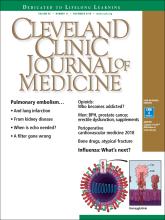Most patients admitted with pulmonary embolism (PE) do not need transthoracic echocardiography (TTE); it should be performed in hemodynamically unstable patients, as well as in hemodynamically stable patients with specific elevated cardiac biomarkers and imaging features.
The decision to perform TTE should be based on clinical presentation, PE burden, and imaging findings (eg, computed tomographic angiography). TTE helps to stratify risk, guide management, monitor response to therapy, and give prognostic information for a subset of patients at increased risk for PE-related adverse events.
RISK STRATIFICATION IN PULMONARY EMBOLISM
PE has a spectrum of presentations ranging from no symptoms to shock. Based on the clinical presentation, PE can be categorized as high, intermediate, or low risk.
High-risk PE, often referred to as “massive” PE, is defined in current American Heart Association guidelines as acute PE with sustained hypotension (systolic blood pressure < 90 mm Hg for at least 15 minutes or requiring inotropic support), persistent profound bradycardia (heart rate < 40 beats per minute with signs or symptoms of shock), syncope, or cardiac arrest.1
Intermediate-risk or “submassive” PE is more challenging to identify because patients are more hemodynamically stable, yet have evidence on electrocardiography, TTE, computed tomography, or cardiac biomarker testing—ie, N-terminal pro-B-type natriuretic peptide (NT-proBNP) or troponin—that indicates myocardial injury or volume overload.1
Low-risk PE is acute PE in the absence of clinical markers of adverse prognosis that define massive or submassive PE.1
Scoring systems to evaluate PE severity include the PE severity index (PESI)2,3 and the Bova grading system.4 The PESI predicts adverse outcomes in acute PE independent of cardiac biomarkers, with risk categorized from lowest to highest as class I to class V (Table 1).4 The Bova score predicts the 30-day risk of PE-related complications in hemodynamically stable patients (Table 2). Points are assigned for each variable, for a maximum of 7. From 0 to 2 points is stage I, 3 to 4 points is stage II, and more than 4 points is stage III. The score is based on 4 variables: heart rate, systolic blood pressure, cardiac troponin level, and a marker of right ventricular dysfunction. The higher the stage, the higher the 30-day risk of PE-related complications.5
Pulmonary Embolism Severity Index (PESI) in risk stratification
Bova scoring system for estimating 30-day risk of complications or death in acute pulmonary embolism
ECHOCARDIOGRAPHIC FEATURES OF HIGH-RISK PULMONARY EMBOLISM
Certain TTE findings suggest increased risk of a poor outcome and may warrant therapy that is more invasive and aggressive. High-risk features include the following:
Impaired right ventricular function
Interventricular septum bulging into the left ventricle (“D-shaped” septum)
Dilated proximal pulmonary arteries
Increased severity of tricuspid regurgitation
Elevated right atrial pressure
Elevated pulmonary artery pressure
Free-floating right ventricular thrombi, which are associated with a mortality rate of up to 45% and can be detected in 7% to 18% of patients6
Tricuspid annular plane systolic excursion, an echocardiographic measure of right ventricular function1; a value less than 17 mm suggests impaired right ventricular systolic function7
The McConnell sign, a feature of acute massive PE: akinesia of the mid-free wall of the right ventricle and hypercontractility of the apex.
These TTE findings often lead to treatment with thrombolysis, transfer to the intensive care unit, and activation of the interventional team for catheter-based therapies.1,8 Free-floating right heart thrombi or thrombus straddling the interatrial septum (“thrombus in transit”) through a patent foramen ovale may require surgical embolectomy.8
PATIENT SELECTION AND INDICATIONS FOR ECHOCARDIOGRAPHY
TTE is indicated in all patients with high-risk PE who are hemodynamically unstable and present with shock, syncope, cardiac arrest, tachycardia (heart rate > 100 beats per minute), or persistent sinus bradycardia (heart rate < 40 beats per minute) (Table 3).4,9 TTE is also recommended for hemodynamically stable patients with evidence of right ventricular dysfunction or strain on computed tomographic angiography, elevation of troponin or NT-proBNP, or new complete or incomplete right bundle branch block or anteroseptal ST or T-wave changes on electrocardiography.8 A more objective assessment recently developed for risk stratification uses clinically driven scores: a PESI score of 86 to 105 (class III) or a simplified PESI score of 1 or higher warrants TTE.2,3
Indications for transthoracic echocardiography in pulmonary embolism
- Copyright © 2018 The Cleveland Clinic Foundation. All Rights Reserved.






